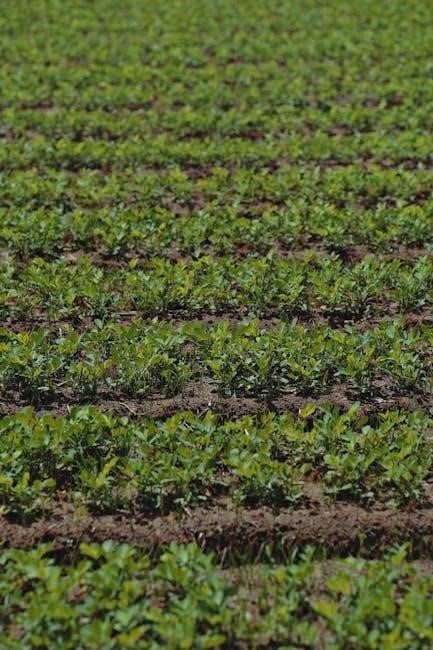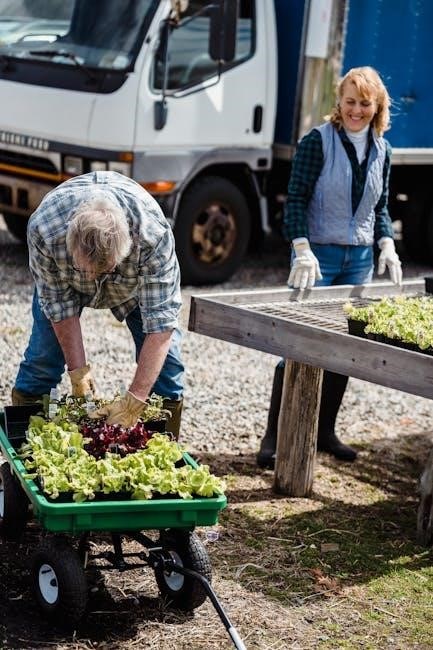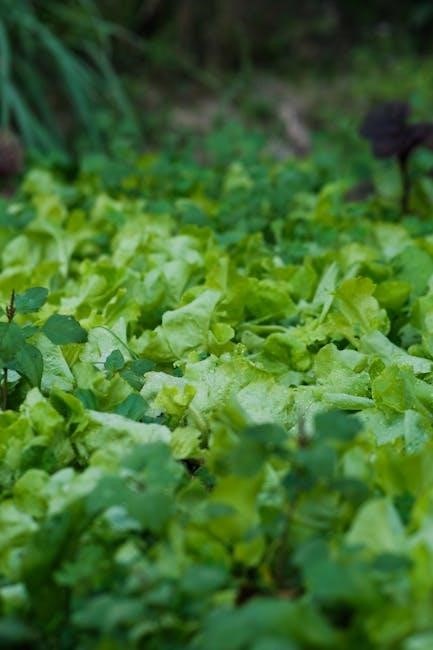Spring Farm Parkway Stage 3 represents a critical phase in the development of a major east-west transportation link in Sydney’s southwest. This stage focuses on connecting key infrastructure, including the Camden Bypass and Hume Motorway, to enhance regional accessibility and support economic growth. The project is designed to alleviate traffic congestion and improve connectivity for residents and businesses in the region.
Overview of the Project
Spring Farm Parkway Stage 3 is a key infrastructure project aimed at improving connectivity in Sydney’s southwest. It involves constructing a vital east-west link to connect Camden Bypass and the Hume Motorway, enhancing traffic flow and accessibility for residents and businesses. The project is designed to address growing transportation demands, reduce congestion, and support regional economic growth. By providing a direct route, Stage 3 will play a crucial role in improving travel efficiency and fostering development in the area. The project aligns with broader regional planning goals.
Importance of Stage 3 in the Parkway Development
Stage 3 of the Spring Farm Parkway is pivotal for enhancing connectivity in Sydney’s southwest. It bridges critical gaps in the regional transport network by linking Camden Bypass and the Hume Motorway, reducing congestion and improving travel efficiency. This phase is essential for supporting economic growth, facilitating access to key areas, and accommodating increasing population demands. By prioritizing Stage 3, the project ensures a robust foundation for future parkway developments, making it a cornerstone of the region’s infrastructure strategy and a catalyst for long-term prosperity.

Stage 3 Development Details
Spring Farm Parkway Stage 3 involves constructing a 3-kilometre east-west link, with Jacobs Australia designing the connection to enhance regional transport infrastructure and improve accessibility.
Current Progress and Timeline
The Spring Farm Parkway Stage 3 project is currently in its early construction phase, with earthwork and pavement installation underway. The project is expected to be completed by mid-2024, pending weather conditions and unforeseen delays. Key milestones include the completion of major intersections by late 2023 and final landscaping by early 2024. The timeline aligns with broader regional transport upgrades, ensuring seamless integration with future stages. Regular updates are available through Transport for NSW, providing transparency on progress and upcoming works.
Design and Construction Plans
The Spring Farm Parkway Stage 3 features a dual-carriageway design with four lanes, ensuring improved traffic flow and safety. The construction includes upgraded intersections, pedestrian pathways, and dedicated cycling lanes. Drainage systems are being implemented to manage stormwater effectively. The project incorporates eco-friendly designs, such as native landscaping and noise barriers. Construction materials include high-strength concrete for pavements and durable road surfacing. Advanced technology, like intelligent transportation systems, will enhance traffic management. The design aligns with future expansion plans, ensuring scalability and long-term functionality for the growing region.

Map and Visual Guides
The official Spring Farm Parkway Stage 3 map PDF provides a detailed visual representation of the project, highlighting key features, intersections, and proposed upgrades for public reference.
Understanding the Stage 3 Map
The Stage 3 map provides a comprehensive visual layout of the Spring Farm Parkway project, detailing road alignments, intersections, and upgraded sections. It highlights key connections, such as links to Camden Bypass and Hume Motorway, and shows the integration of new infrastructure with existing roads. The map includes a legend explaining symbols and scale, helping users interpret the design. It also identifies environmental zones and community access points, ensuring clarity on how the project aligns with local needs and broader transportation goals.
Key Features and Landmarks
The Stage 3 map highlights critical features such as major intersections, upgraded road alignments, and new infrastructure. Key landmarks include the connection points to Camden Bypass and Hume Motorway, ensuring seamless travel. The map also identifies pedestrian and cycling paths, enhancing accessibility for all users. Notable structures like bridges and interchanges are marked, showcasing the project’s scale. These features aim to improve traffic flow, reduce congestion, and provide safer pathways for residents and commuters, aligning with the region’s transportation and community goals.

Environmental and Community Impact
The project undergoes rigorous environmental assessments to minimize ecological disruption. Community engagement ensures resident concerns are addressed, fostering sustainable development and improved quality of life locally.
Environmental Assessment and Management
The Spring Farm Parkway Stage 3 project includes a comprehensive environmental assessment to identify potential impacts on biodiversity, water quality, and noise levels. Management strategies, such as tree preservation and noise barriers, are implemented to mitigate risks. Regular monitoring ensures compliance with environmental standards, while community consultations provide a platform for feedback. This balanced approach aims to protect the ecosystem while delivering essential infrastructure, ensuring sustainable development for future generations. The project adheres to strict environmental regulations to minimize its ecological footprint.

Community Consultation and Feedback
Community consultation is a key component of the Spring Farm Parkway Stage 3 project, ensuring residents and stakeholders are informed and involved. Public meetings, online surveys, and information sessions have been conducted to gather feedback on design, connectivity, and environmental impacts. Feedback is analyzed to refine plans and address concerns, fostering a collaborative approach. Transparency and open communication are prioritized to build trust and ensure the project aligns with community needs and expectations, creating a shared vision for the region’s future development and connectivity.
Transportation and Connectivity
Spring Farm Parkway Stage 3 enhances local connectivity, improving traffic flow and reducing congestion. It integrates seamlessly with Camden Bypass and Hume Motorway, boosting regional accessibility.
Linking Camden Bypass and Hume Motorway
The Spring Farm Parkway Stage 3 will create a direct link between Camden Bypass and Hume Motorway, significantly enhancing regional connectivity. This strategic connection aims to reduce traffic congestion and improve access to major highways, benefiting both commuters and freight operators. By streamlining traffic flow, the project will reduce travel times and enhance safety, fostering economic growth and improving quality of life for residents.

Impact on Local Traffic and Accessibility
The Spring Farm Parkway Stage 3 will significantly improve local traffic flow and accessibility, reducing congestion in surrounding areas. By enhancing connectivity, the project will provide easier access to residential zones, commercial centers, and key amenities. This will benefit daily commuters and local businesses, fostering economic activity. Improved road infrastructure will also support safer travel conditions and accommodate future population growth, ensuring the region remains vibrant and well-connected.

Economic and Social Benefits
The Spring Farm Parkway Stage 3 enhances regional connectivity, stimulating economic growth and creating jobs. Improved infrastructure supports local businesses and fosters community development.
Economic Growth and Development
The Spring Farm Parkway Stage 3 is expected to drive significant economic growth by improving connectivity and reducing travel times. Enhanced infrastructure will attract businesses, support local industries, and boost property values. The project will create jobs during construction and foster long-term employment opportunities in various sectors. Improved accessibility will also stimulate investment, benefiting both residents and businesses in the region. This development is a crucial step in strengthening the local economy and ensuring sustainable growth for future generations.
Social Implications for the Region
The Spring Farm Parkway Stage 3 will have positive social implications by enhancing community connectivity and improving quality of life. It will provide better access to essential services, schools, and recreational facilities, benefiting families and residents. The upgraded infrastructure will reduce travel time, fostering a more connected and cohesive community. Improved safety and reduced congestion will also contribute to a more enjoyable living environment. This project aims to create a more inclusive and accessible region for all residents, promoting social equity and well-being.
Government and Stakeholder Involvement
Transport for NSW leads the Spring Farm Parkway Stage 3 project, collaborating with local councils, stakeholders, and community groups to ensure alignment with regional needs and standards.
Role of Transport for NSW
Transport for NSW plays a pivotal role in delivering Spring Farm Parkway Stage 3, overseeing project planning, design, and construction. They ensure compliance with safety and environmental standards, manage community consultations, and coordinate with stakeholders. Transport for NSW also handles budget allocation and regulatory approvals, ensuring the project aligns with broader transport strategies. Their oversight guarantees efficient delivery and integration with existing infrastructure, supporting regional connectivity and economic growth while addressing community needs.
Partnerships and Collaborations
Spring Farm Parkway Stage 3 relies on strong partnerships between Transport for NSW, local councils, and external stakeholders. Collaborations with engineering firms and community groups ensure diverse expertise and resource sharing. These partnerships facilitate efficient project delivery, addressing both technical and community needs. Environmental agencies are also engaged to manage ecological impacts. Such collaborations enhance transparency, accountability, and overall project success, ensuring the parkway aligns with regional goals and benefits all stakeholders effectively.
Legal and Regulatory Framework
The project adheres to the Environmental Planning and Assessment Act, ensuring compliance with environmental and safety standards. Regulatory frameworks guide construction and land use.
Environmental Planning and Assessment Act
The Environmental Planning and Assessment Act governs the development of Spring Farm Parkway Stage 3, ensuring compliance with environmental and planning regulations. The project requires rigorous environmental impact assessments to minimize ecological disruption. Public consultations and transparency are mandated, aligning with community expectations. The act ensures sustainable development, balancing infrastructure growth with environmental protection. Adherence to this framework guarantees that the project meets legal standards, promoting accountability and responsible construction practices throughout the Spring Farm Parkway Stage 3 development.
Compliance and Regulatory Requirements
Spring Farm Parkway Stage 3 must adhere to strict compliance and regulatory requirements to ensure the project meets legal, safety, and environmental standards. These requirements include obtaining necessary approvals, permits, and adhering to environmental regulations. The project must comply with state and federal laws, including environmental impact assessments and heritage protections. Regular audits and inspections are conducted to ensure adherence to these standards. Compliance ensures the project is delivered safely, efficiently, and sustainably, aligning with community expectations and legal obligations. This rigorous process guarantees accountability and transparency throughout the development.
Funding and Budget
The Spring Farm Parkway Stage 3 project is supported by allocated funds from Transport for NSW and federal grants. Budget management ensures efficient resource allocation.
Allocation of Resources
Resources for Spring Farm Parkway Stage 3 are allocated to ensure balanced development across design, construction, and environmental management. Funds are distributed to prioritize road upgrades, landscaping, and utility installations. A significant portion is dedicated to earthwork and pavement construction, while a smaller allocation addresses community feedback and sustainability initiatives. Regular monitoring ensures resources are used efficiently, with adjustments made to align with project timelines and budget constraints. Transparent allocation practices maintain stakeholder trust and project accountability.
Funding Sources and Budget Breakdown
The Spring Farm Parkway Stage 3 project is funded through a combination of government grants, state allocations, and private contributions. The total budget is divided into key sectors: 60% for road infrastructure, 20% for design and planning, 10% for environmental measures, and 10% for community engagement. Funds are allocated to ensure project sustainability and community benefits, with regular audits to maintain transparency. This balanced approach supports both immediate construction needs and long-term regional development goals.

Future Stages and Expansion
Future stages aim to extend connectivity, enhancing regional access and supporting growth. Long-term plans focus on integrating with surrounding infrastructure, ensuring sustainable transportation solutions for the region.
Plans for Subsequent Stages
Subsequent stages of the Spring Farm Parkway aim to enhance connectivity and support regional growth; Future plans include extending the parkway to link key transport hubs, improving traffic flow, and integrating with nearby infrastructure. These stages will focus on addressing long-term transportation needs while aligning with urban development strategies. Detailed designs and timelines are being refined, ensuring seamless progression from Stage 3. Community feedback will continue to shape these plans, prioritizing accessibility and sustainability for future generations.

Long-Term Vision for the Parkway
The long-term vision for Spring Farm Parkway envisions a seamless transportation network supporting regional growth. It aims to reduce congestion, enhance connectivity, and foster economic opportunities. The parkway will serve as a critical link, integrating urban and rural areas while promoting sustainable development. Future plans emphasize improved accessibility, environmental balance, and resilience. By prioritizing innovation and community needs, the parkway will become a cornerstone of the region’s infrastructure, driving progress for generations to come.
Accessing the Stage 3 Map PDF
The Stage 3 map PDF is accessible via official sources. Visit Transport for NSW or local council websites for the most accurate and updated documents.

Official Sources for the Map
The Spring Farm Parkway Stage 3 map PDF is available through official channels, including Transport for NSW and Camden Council websites. These platforms provide verified documents. Visit the Transport for NSW website and navigate to the “Projects” or “Planning” section. Additionally, local government portals may host the map for public access. Ensure you download the PDF from reputable sources to guarantee accuracy and reliability. Always check for the latest updates, as maps are subject to revisions during project development.
How to Download and Use the Map
To access the Spring Farm Parkway Stage 3 map PDF, visit the official Transport for NSW website. Navigate to the “Projects” section and search for “Spring Farm Parkway.” Click on the Stage 3 link to find the downloadable PDF. Once downloaded, open the file using a PDF viewer. Zoom in to view detailed sections or print it for reference. Use the map to identify key intersections, road alignments, and nearby landmarks. Regularly check the website for updates, as the map may be revised during construction.